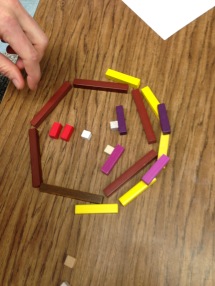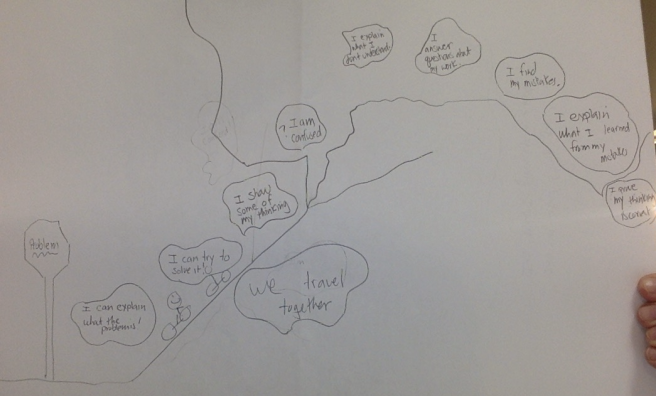Recently, I have been fascinated by the resurfacing of the counting and cardinality standards in third grade. Third grade is when students start exploring multiplication and division. They have just spent three years grappling with how to count, add, and subtract whole numbers.
They started the journey in Kindergarten wrestling with the fact that one digit could represent multiple items. Minds were blown by this concept. Just when they started to apply it, they came across the number 10. What ?!? two digits – one and zero – can represent ten items. That number “1” now means “1” ten?!? Craziness. Eventually, these same students developed deep understandings of some important units in our number system: one, ten, 100, 1,000, 1/2. They learned how to take these units apart and put them back together. They used them to represent and understand their world.
Now, they enter third grade and we start presenting situations where 1 can mean a group of any number of items AND you can have multiple groups of those items. Enter the parallel progression.
In kindergarten, students learn to count a group of objects, they pair each word said with one object. When these same students start to learn multiplication, sometimes, they revert back to counting by ones, especially if the objects they are counting are presented in an array that is composed of numbers that make skip counting challenging.
Watch Jack:
When students were in Kindergarten, they learned that the last number name said in counting tells the number of objects counted. When students work with arrays, they may take some time to construct the understanding that a 7×7 array that is subdivided contains the same amount of squares as a 7×7 array that is not subdivided. They wonder, do they really both have 49 squares in them?
Take a look:
I asked this student which one of these boxes of truffles was easiest to determine a total. His answer is a reflective and clear statement about why this progression is challenging

I am fascinated by how students progress from using and understanding units of 1 “item” to using and understanding units of “1 group”.
When Jack and I were talking about how the two subdivided arrays were different, he commented on the different numbers he used to do the subdividing. I asked him, “What does that 3 mean? ” He struggled to come up with the words to describe it. He tried “three slots of truffles in a line at the top”, but he recognized that his words weren’t capturing his meaning. I decided to focus on the middle array since that was the one he proclaimed was easiest because he could skip count. He could “see” and use the groups in the middle array.
Listen to him. You can hear him revising his thinking about “items” and “groups”.

After students are comfortable using skip counting, they usually start thinking about and using repeated addition. This is when they start grouping their groups. Listen to Ellen describe how she knew the amount of truffles in these arrays:
I have talked a lot about how I think the Counting and Cardinality progression resurfaces in third grade. Now, let’s look at the Operations and Algebraic Thinking progression as it applies to third grade. If you haven’t read the progressions documents that are on Bill McCallum’s website, you really should. I reread them all the time. They really help me understand the standards.
Here are some quotes from the third grade section of the OA progression. See if you recognize any of these in the videos you just watched:
- “In the Array situations, the roles of the factors do not differ. One factor tells the number of rows in the array, and the other factor tells the number of columns in the situation. But rows and columns depend on the orientation of the array. If an array is rotated 90 degrees, the rows become columns and the columns become rows. This is useful for seeing the commutative property for multiplication”
The progressions describe three levels of representing and solving multiplication and division problems:
- “Level 1 is making and counting all of the quantities involved in a multiplication or division situation.”
- “Level 2 is repeated counting on by a given number, such as for 3: 3, 6, 9, 12, 15, 18, 21, 24, 27, 30. The count-bys give the running total. The number of 3s said is tracked with fingers or a visual or physical (e.g., head bobs) pattern.”
- “Level 3 methods use the associative property or the distributive property to compose and decompose. These compositions and decompositions may be additive (as for addition and subtraction) or multiplicative.”
I want to understand more about how children use what they have constructed about counting, addition, and subtraction and apply it to make meaning of multiplication and division situations. Bill McCallum says, “These skills and understandings are crucial; students will rely on them for years to come as they learn to multiply and divide with multi-digit whole number and to add, subtract, multiply and divide with fractions and with decimals.”
I wonder if we give them enough time to really explore the connections between these concepts. I also wonder if we give them enough time to defend and question the ideas they are developing.
I also wonder:
- Would these students have used the same strategies if I showed them this picture:

- How could I help Erin see her addition statement, “I know 5+5 =10 and 10+10 =20” as a multiplication statement, “2 groups of 2 groups of 5”. Is Erin thinking intuitively about associativity?
- Are certain properties more intuitive to certain kids or is it about what learning opportunities they are exposed to?
I wonder. I wonder. I wonder. What do you wonder?







 : achieving or producing a significant amount or result.
: achieving or producing a significant amount or result.






















